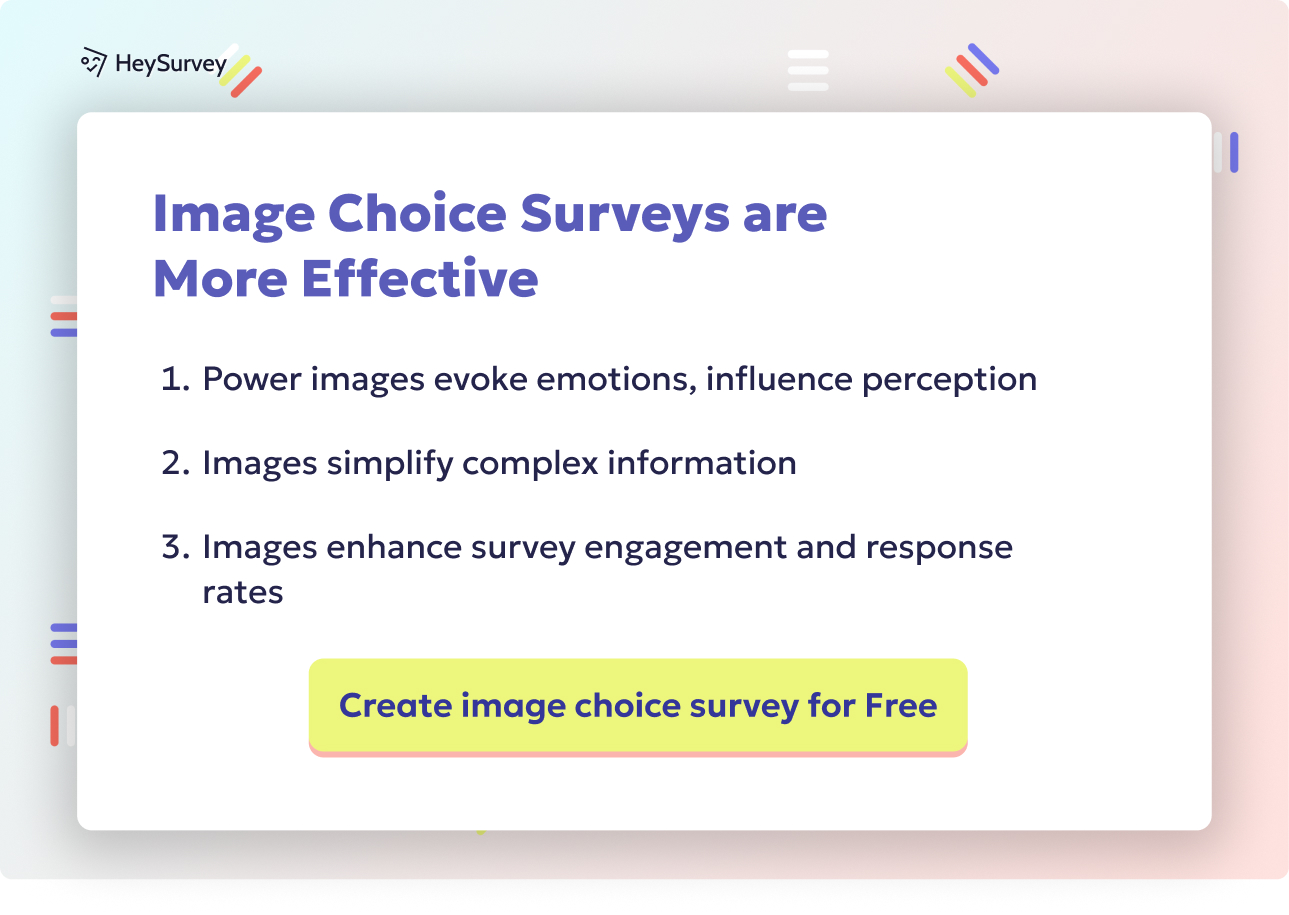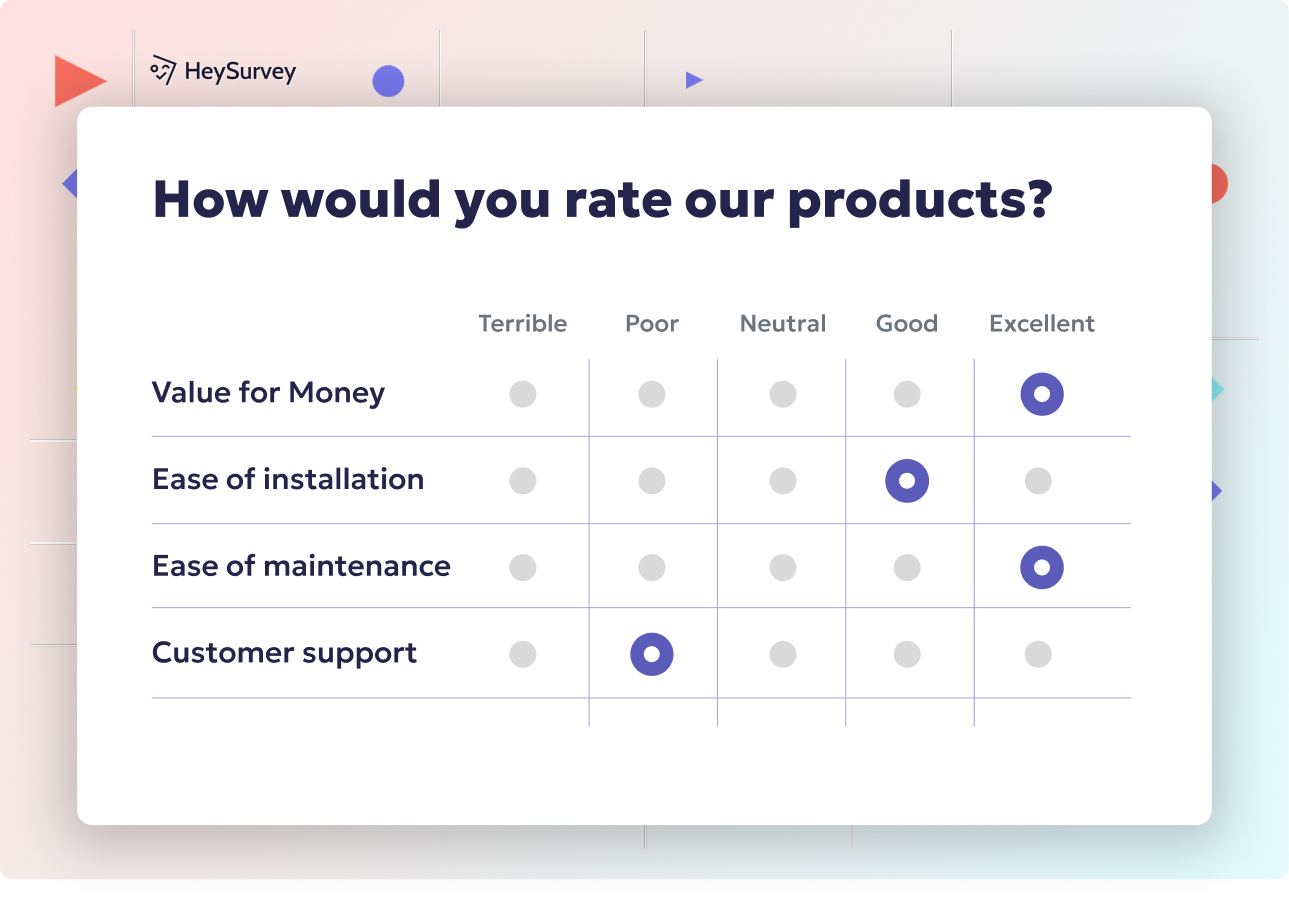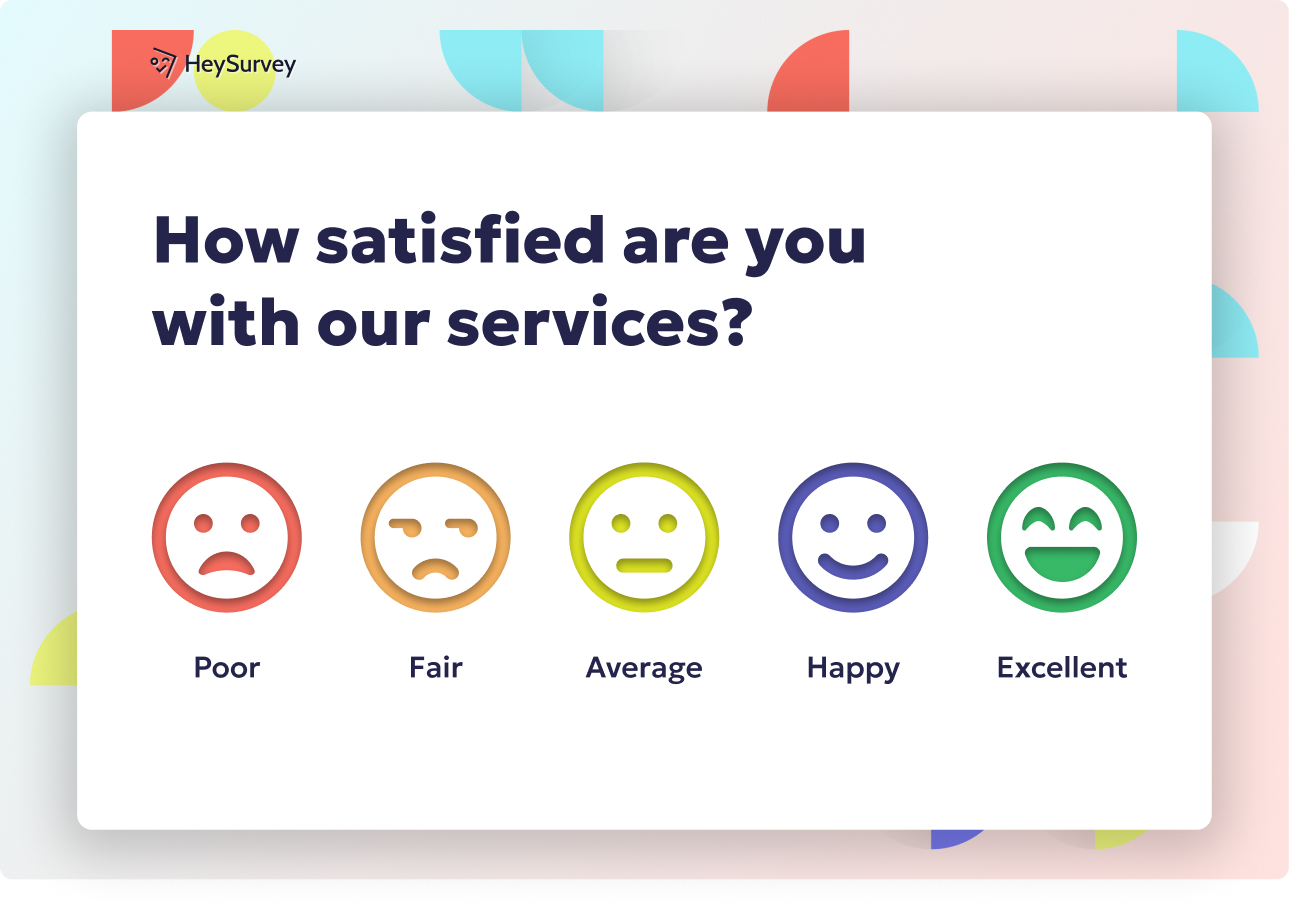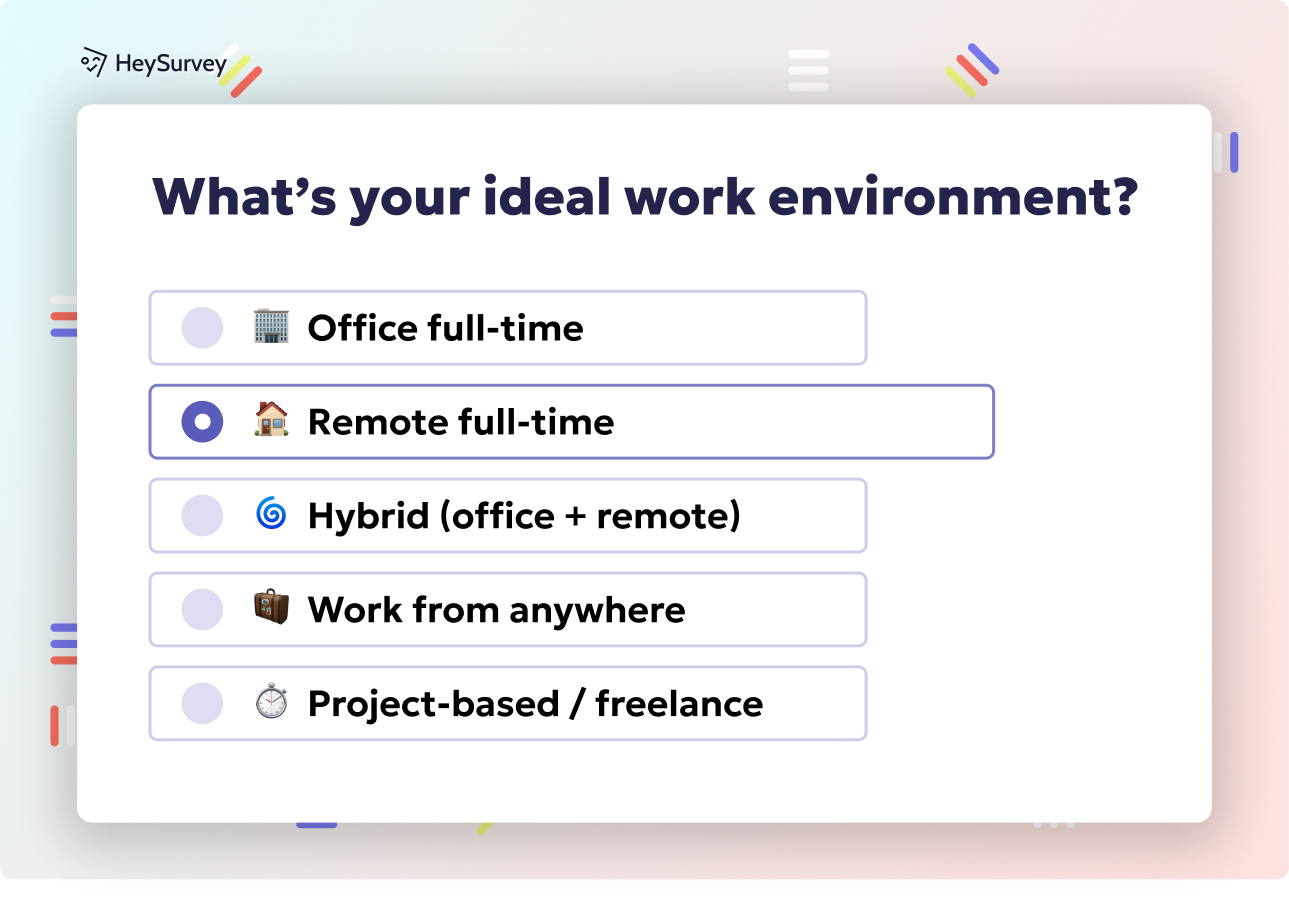29 Post-Meeting Survey Questions to Improve Future Meetings
Discover 25+ post meeting survey questions to capture actionable feedback and improve future meetings with ease and clarity.
Post-meeting survey questions are the unsung heroes of organizational improvement. When used after key gatherings—think team catch-ups, project kickoffs, and board huddles—they become your secret weapon for actionable feedback. Whether you want to enhance after-meeting feedback, boost meeting engagement, or simply improve future meetings, capturing honest reactions is the first step. In this guide, you'll uncover six powerful survey types that unlock higher response rates, sharper insights, and stronger follow-through to propel your meetings from “meh” to magical.
Quick Pulse Surveys
Why & When to Use
Quick pulse post-meeting surveys are the espresso shots of feedback. They’re perfect when you need to gather real-time meeting feedback instantly, such as after daily stand-ups, sprint reviews, or lively town halls. These mini-surveys typically consist of just three to five carefully crafted questions, which means they're fast and painless to complete.
Pulse post-meeting surveys work best: - Directly after meetings that happen frequently. - When teams want to rapid-fire iterate on process or format. - For remote or hybrid check-ins where you’re racing against digital fatigue.
Why fuss about speed? When feedback takes just a minute or two, more people actually respond. You get a broad, honest sample—before memories fade away. Plus, since these are mobile-friendly, team members can whip out their phones and provide input before they’ve even left their seats.
The magic of quick pulses is their immediacy. Responses reflect the freshest sentiment, so you see which agenda items landed, who felt included, and where confusion lurked. Over time, tracking these responses helps spot trends—like a steady improvement in clarity or a consistent drop in team energy on Mondays.
Sample Questions
On a scale of 1–5, how clear were today’s next steps?
Did you feel today’s meeting respected your time?
Was your top concern addressed during this meeting?
Rate the overall energy of this meeting from 1–5.
How likely are you to use what was discussed today before the next meeting?
With these laser-focused questions, you’ll generate feedback that’s quick to collect and even quicker to act on!
Pulse surveys, when conducted effectively and followed by prompt action, can significantly enhance employee engagement and trust within an organization. (achievers.com)

Creating a post-meeting survey with HeySurvey is a walk in the park—even if you've never tried a survey builder before. Here’s how to get your survey off the ground in just three easy steps:
Step 1: Create a New Survey
- Head over to HeySurvey and select Create New Survey.
- You can start from scratch with an empty sheet or jump right in by picking a relevant template designed for post-meeting feedback.
- Give your survey an internal name that helps you recognize it later (like “Team Meeting Feedback - May 2024”).
- Voilà! You’re now in the Survey Editor, where your survey journey truly begins.
Step 2: Add Questions
- Click the Add Question button at the top or wherever you want to insert questions.
- Choose from question types like Scale, Choice, Text, or Multiple Choice depending on what feedback you need.
- Type your post-meeting survey questions, like “On a scale from 1 to 5, how clear were the next steps?” or “What could we improve in future meetings?”
- Mark key questions as required to get all the necessary info without missing a beat.
- You can spice it up by adding images or short descriptions to help clarify questions.
Step 3: Publish Your Survey
- Once your questions are locked in, hit the Preview button to see how your survey looks on desktop and mobile.
- Tweak the design if needed using the Designer Sidebar—think colors, fonts, and layouts for that professional touch.
- When you’re happy, click Publish. Note: you’ll need to sign up or log in to publish and collect responses.
- Copy the shareable link or embed the survey in your emails or team platforms. Send it out right after your meeting to grab that fresh after-meeting feedback!
Bonus Step 1: Apply Branding
- Upload your company logo to keep your survey on-brand and recognizable.
- Use the Designer Sidebar to customize colors and fonts so your survey matches your team’s vibe.
Bonus Step 2: Define Settings
- Set open and close dates for survey availability to control when responses are accepted.
- Limit the total number of responses if needed.
- Create a thank-you page or redirect respondents to a specific URL after completion.
Bonus Step 3: Use Branching (Skip Logic)
- Customize the path of your survey by using branching to skip irrelevant questions based on answers.
- For example, if someone isn’t involved in decision-making, they can skip detailed decision alignment questions automatically.
With these simple steps, you’ll turn your post-meeting survey questions into actionable insights in no time—making your meetings smarter, smoother, and way more productive! When you’re ready, hit the button below to open a survey template and start customizing.
Comprehensive Feedback Surveys
Why & When to Use
Comprehensive feedback surveys go beyond the basics. They’re your all-access passes for a detailed post-meeting questionnaire, best reserved for high-stakes business reviews, strategy sessions, and training workshops where you want to dig deep.
This survey type is essential for: - Quarterly business reviews with stakeholders and leadership. - Strategic planning sessions that set big-picture directions. - Training workshops where lasting knowledge transfer matters.
When it’s time to examine everything—agenda, facilitation, logistics, and tangible outcomes—comprehensive surveys provide the full story. These surveys are a bit longer (think 8–15 questions), but every question is a chance to uncover deeper insights.
Attendees have the space to specify what worked and what bombed. That could mean calling out the perfect break schedule, lauding a lively speaker, or pointing out where the Wi-Fi lagged. In other words, you’re not just scratching the surface—you’re diving in for gold.
Sample Questions
Which agenda item added the most value, and why?
Was the meeting facilitated effectively? Please explain your rating.
Did the meeting objectives align with your expectations?
How satisfied were you with the logistics and scheduling?
What would you change to improve the effectiveness of future meetings?
Were opportunities for participant engagement sufficient?
How clear were the roles and responsibilities discussed today?
Which part of the meeting was least useful, and why?
Were materials and pre-reads sent in advance and useful?
Do you feel the topics discussed were prioritized appropriately?
Comprehensive feedback transforms your meeting effectiveness survey into a treasure trove of actionable insight, empowering organizations to not just meet, but masterfully meet!
Regular post-meeting evaluations can boost productivity by up to 12.5%. (meetjamie.ai)
Engagement & Participation Surveys
Why & When to Use
Let’s be honest—what’s the point of meetings if people zone out or never speak up? Meeting engagement surveys are built to find out. They are especially handy for cross-functional collaborations, creative brainstorms, and any virtual or hybrid calls where screen fatigue lingers.
Use these surveys: - When you need to know if everyone felt invited to contribute. - To ensure remote and in-person participants both felt included. - For brainstorming sessions where diversity of ideas fuels innovation.
Strong participation feedback isn’t just about hand-raising. It’s about discovering if the room felt safe, if discussions were balanced, and whether participants left energized—instead of checked out. When inclusion shines, innovation grows. Plus, engagement metrics can help leaders see where conversations stall, and where facilitation can be tweaked.
Don’t underestimate the power of these insights! They’re not just for HR—they give managers tangible ways to boost creativity, foster collaboration, and even retain top talent.
Sample Questions
Did you feel comfortable voicing your opinions today?
Were different perspectives encouraged and respected?
Did you have enough opportunities to participate in the discussion?
How inclusive did you find this meeting?
Did you leave the meeting feeling more connected to your team?
Were there moments when certain voices dominated the conversation?
Did technology support or hinder active participation?
Were meeting norms or ground rules clearly communicated?
On a scale of 1–5, how engaging did you find the facilitator?
Participation feedback: when you measure it, you manage it—hello, more dynamic meetings!
Decision Alignment Surveys
Why & When to Use
Nothing’s worse than leaving a meeting with everyone nodding and no one actually agreeing on what’s been decided. Enter the decision alignment survey! This robust check-in is vital for project kickoffs, critical steering committees, and those game-changing budget approvals.
Pull out this survey when: - Your meeting involves choosing between action paths or finalizing big decisions. - You want to avoid costly misunderstandings or resistance to change. - You're driving a change-management process that relies on strong buy-in.
Directly after key decision moments, these surveys help teams assess clarity, confidence, and commitment. If gaps emerge, you can address them while momentum’s still hot. This mitigates project risks and ensures that deliverables aren’t stalled by miscommunication.
Aligned decisions aren't just about following the plan—they're about understanding why the plan was chosen. This is where real change happens, and where new initiatives take off smoothly.
Sample Questions
Do you fully understand the rationale behind the decision on X?
Are you personally aligned with the decision(s) made today?
How confident are you that these decisions will be implemented successfully?
What concerns, if any, do you have about the decisions made in this meeting?
Was the process for reaching a decision transparent and fair?
Do you know your next steps based on today’s decision(s)?
Are there unresolved questions regarding the decision(s) made?
Was enough time given to discuss each option before deciding?
Decision alignment surveys give you a snapshot of team buy-in, so you can smooth out bumps before they turn into roadblocks.
Incorporating relevant topics in post-meeting surveys can increase response rates by up to 40%. (supersurvey.com)
Action-Planning & Accountability Surveys
Why & When to Use
Every meeting that ends with a fresh task list needs an accountability survey after meeting—your trusty companion for verifying action items, deadlines, and team readiness. These are particularly clutch for retrospectives, project launches, and client handoffs.
Deploy these surveys: - After meetings where responsibilities are assigned. - For sessions that result in to-do lists or key deliverables. - To spot potential delays before they happen and clarify ownership.
When tasks fall through the cracks, it’s usually because owners, resources, or timelines are unclear. The accountability survey after meeting exposes these friction points so your team can resolve them quickly. It’s like turning up the brightness on everyone’s action items—no more missed tasks or fuzzy deadlines!
By nipping confusion in the bud, you foster reliability. Teams want to know what’s expected and what they’ll need—these surveys help set the record straight and keep projects moving.
Sample Questions
Do you clearly understand your assigned action items from this meeting?
Are you confident you have what you need to complete your assigned action item?
Were due dates for all action items agreed upon and documented?
Who should you contact if you encounter a roadblock?
Are there any action items you believe require more clarification?
How likely are you to complete your action(s) before the next check-in?
Do you anticipate needing support or resources to deliver as promised?
Accountability isn’t a dirty word. With the right feedback, it becomes your team’s safety net for flawless follow-through.
Follow-Up Effectiveness Surveys
Why & When to Use
A great meeting today can fizzle by next month. That’s why deploying a follow-up meeting survey 1–4 weeks post-meeting is so powerful—especially for long-running projects, culture shifts, or recurring leadership reviews.
Use follow-up surveys when: - You want to ensure commitments from previous meetings were kept. - Checking sustained clarity or buy-in after major decisions. - Assessing real-world impact in ongoing initiatives.
Post-meeting progress feedback surveys bridge the gap between intention and execution. They capture whether deliverables materialized, questions were answered, or issues popped up—even weeks later. This is your safeguard against “meeting amnesia” and accountability lapses.
Leaders know: what gets measured, gets managed. Regular follow-up signals a commitment to continuous improvement and keeps teams aligned beyond meeting day.
Sample Questions
Have the decisions from our last meeting been fully implemented?
Were any commitments made during the last meeting not yet fulfilled?
What challenges have come up since the meeting?
Has your understanding of key outcomes changed in the weeks since?
Are follow-up actions from the meeting still clear to you?
What could we do better in our next meeting to support ongoing projects?
Did the meeting lead to measurable improvements in your area?
Follow-up meeting surveys give you the long-range view you need to keep progress—and people—on track between sessions.
Dos and Don’ts for Crafting High-Impact Post-Meeting Surveys
Want to transform your post-meeting survey into a feedback magnet? Survey best practices go beyond clever questions or neat formatting. Here’s how to do it right, every time:
- Keep it brief—no one likes an endless quiz.
- Align every question with your core meeting goals.
- Assure participants their feedback will remain anonymous.
- Always avoid leading or biased questions.
- Tailor survey language to your audience.
- Prioritize open-ended questions—but don’t overdo them.
- Test surveys on mobile devices for seamless response.
- Close the loop by sharing survey results with your team.
- Update survey content as meetings evolve.
Survey mistakes are sneaky, though. Common pitfalls include:
- Sending surveys so often teams tune out—hello, survey fatigue.
- Using vague rating scales (“good” means what, exactly?).
- Failing to clarify what happens with open-ended responses.
The big meeting feedback dos and don’ts? Think user-first, match survey to purpose, and always, always act on what you learn. A well-built survey isn’t just a checkbox—it’s the engine of better meetings.
Conclusion – Turning Survey Insights Into Meeting Excellence
Survey insights are your not-so-secret sauce for continuous meeting improvement. Select the right survey type for each context, and you’ll create a feedback-driven culture that values progress over perfection. Analyze responses promptly, share takeaways transparently, and adjust your meeting approach from one round to the next.
Ready to level up? Download a customizable post-meeting survey template and watch your meetings transform from routine to remarkable. Every bit of feedback is your next leap forward!
Related Feedback Survey Surveys

25 Catering Survey Questions to Collect Actionable Feedback
Discover 30 expert catering survey questions to gather actionable feedback that enhances menus, s...

30 User Feedback Survey Questions for Better Insights
Discover 40+ user feedback survey questions across 8 types to boost product insights, UX, and cus...

30+ Environment Survey Questions for Sustainable Insights
Explore 30+ environment survey questions with expert tips covering awareness, behavior, corporate...
